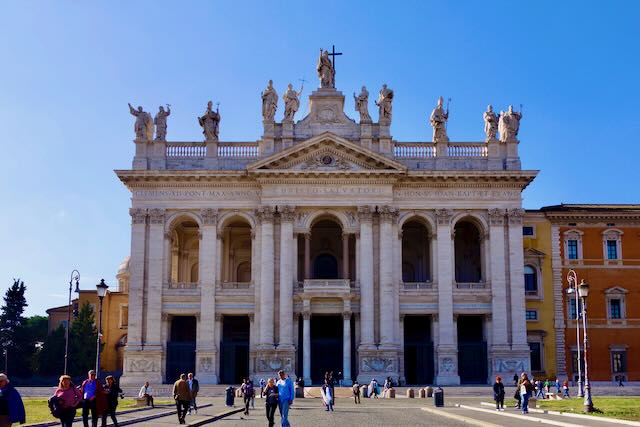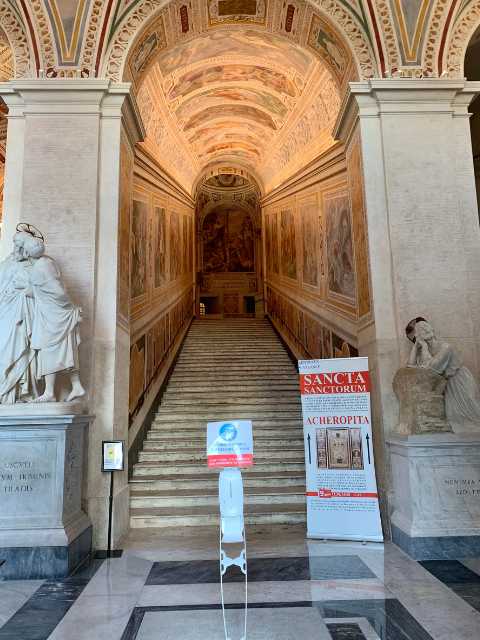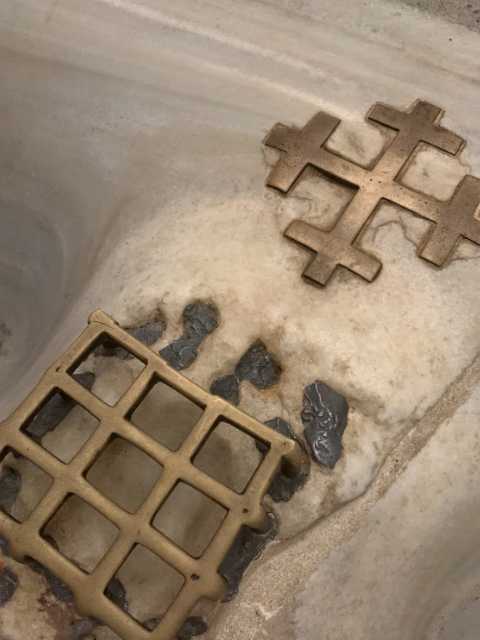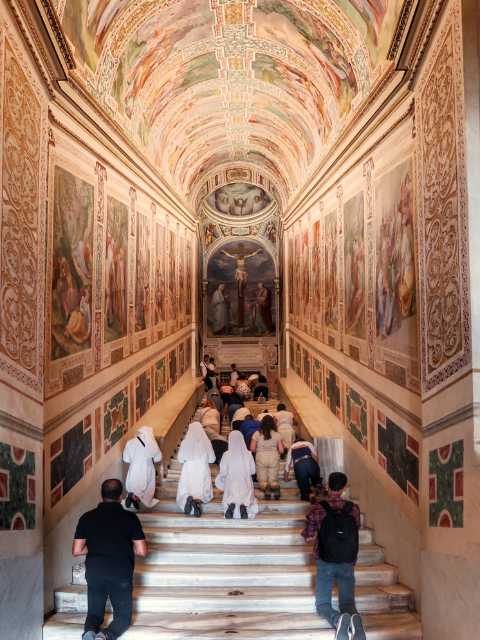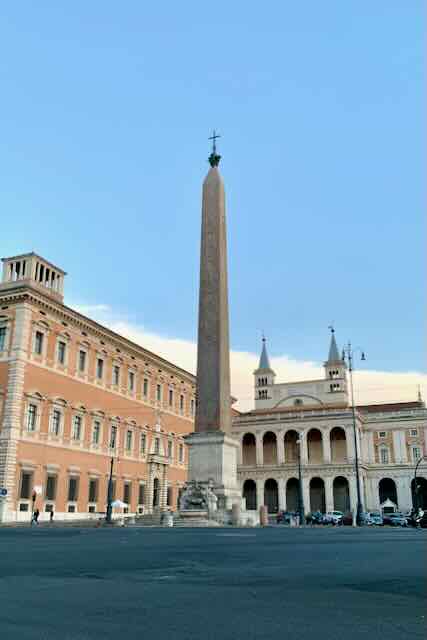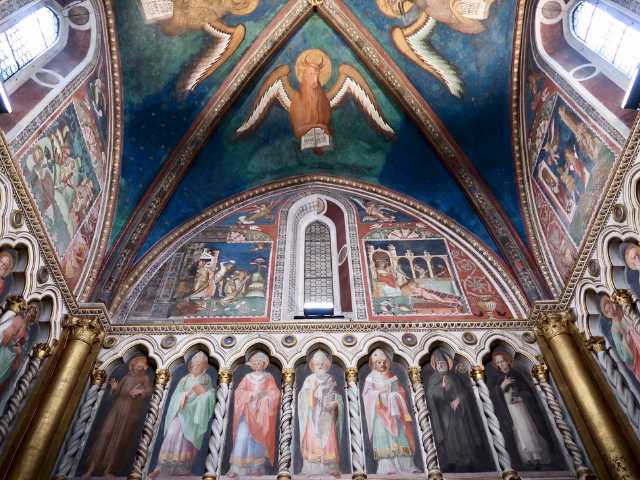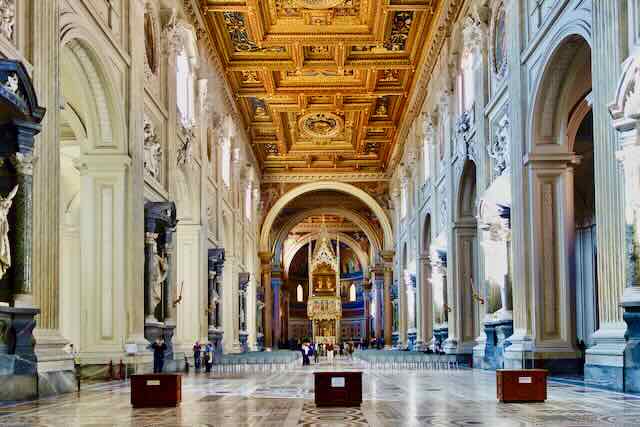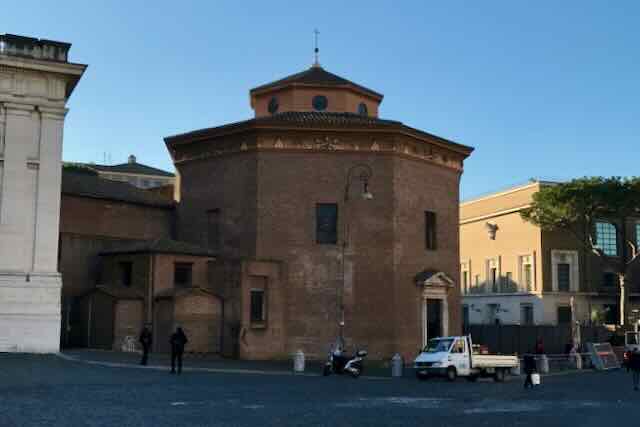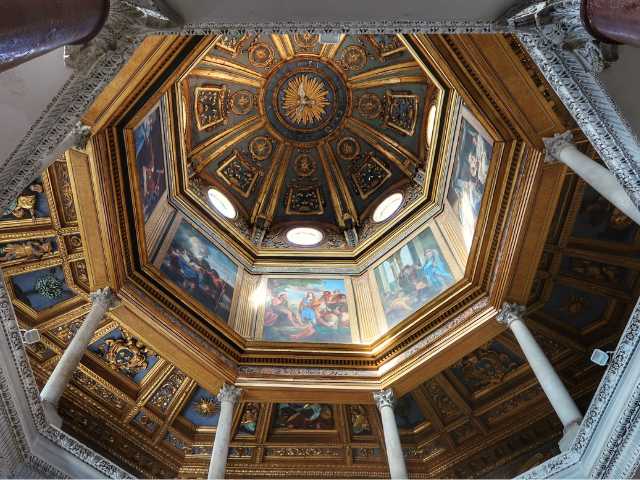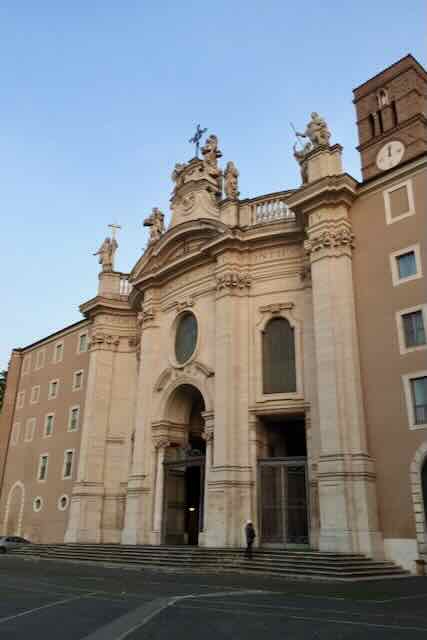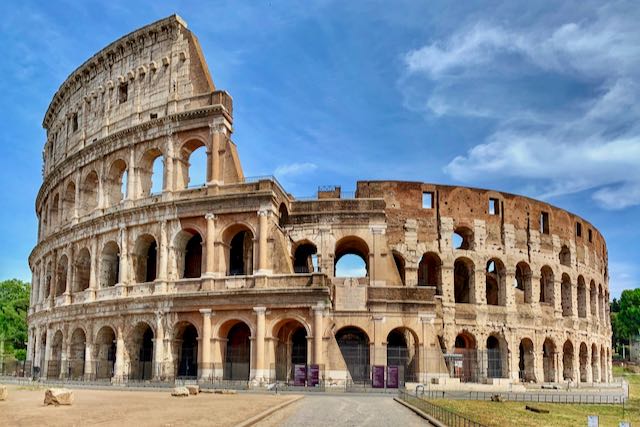- Sign up & get a FREE ebook Subscribe NOW!
- Romewise Home Page
- What to Do in Rome
- scala sancta
Visiting the Holy Stairs, the Scala Sancta in Rome
Have you heard of the Holy Stairs or Scala Sancta in Rome?
This is an interesting and important site to visit, whether you are religious or not.
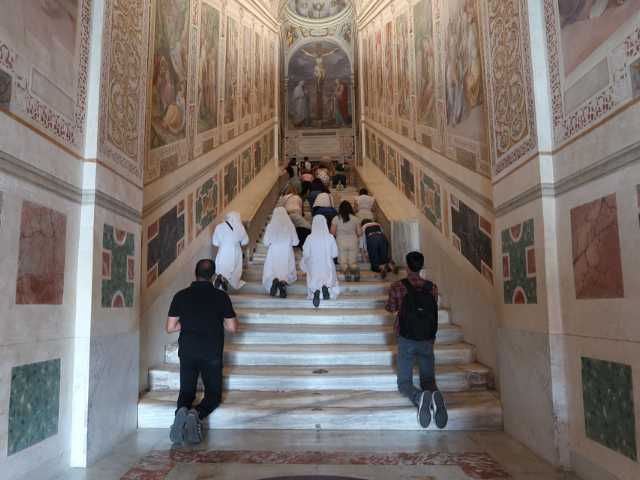 The Holy Stairs in Rome have a history that goes back over two thousand years - keep reading to find out more!
The Holy Stairs in Rome have a history that goes back over two thousand years - keep reading to find out more!Find out why you should see (and maybe even climb) the holy staircase in Rome, and get my top tips for the best way to do it!
The Holy Stairs in Rome - Everything you need to Know
The Holy Stairs, also known as the Scala Sancta in Latin and the Scala Santa in Italian, is a set of 28 marble steps located near the Archbasilica of Saint John in Lateran in Rome.
These steps are believed to have been part of the praetorium (residence) of Pontius Pilate in Jerusalem.
It is said Jesus climbed these steps on the day he was condemned to death.
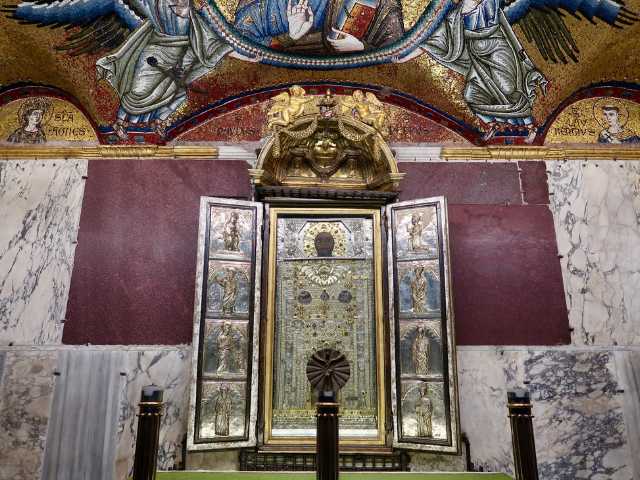 At the top of the Holy Stairs is the Sancta Sanctorum, home to some of the most special relics from the early Christian period
At the top of the Holy Stairs is the Sancta Sanctorum, home to some of the most special relics from the early Christian periodBut how did these steps get to Rome?
Can you visit them?
Can you climb them?
And what happens at the top?
On this page we'll go over:
- What is the significance of the Holy Stairs?
- How did these marble stairs get to Rome? Who brought the Holy Stairs to Rome?
- What are the blood stains on the Holy Stairs?
- What is the Sancta Sanctorum?
- Where is the other Holy Staircase in Rome?
- Climbing the Holy Stairs.
- Practical matters - location, hours, cost, how to visit, what's nearby
What is the significance of the Holy Stairs?
The Holy Stairs are considered a sacred site and are an important pilgrimage destination for Catholics.
Visitors climb the steps on their knees as a sign of devotion, and many believe that doing so will bring them forgiveness for their sins.
The Rome Scala Sancta are an interesting place to visit for several reasons.
First, they offer a unique opportunity to connect with history and spirituality.
The steps have attracted Christian pilgrims for centuries, and the act of climbing them can be a deeply moving and meaningful experience.
Second, the Holy Stairs (Scala Santa) are an example of the rich cultural heritage of Rome.
The steps are housed in a beautiful building that was built specifically to house them, and the intricate artwork and decorations on the walls and ceilings are worth seeing.
Third, the chapel at the top, the Sancta Sanctorum or Holy of Holies, is one of the most important chapels in Rome.
None other than the legendary British writer Charles Dickens was quite impressed:
Of all the many spectacles of dangerous reliance on outward observances, in themselves mere empty forms, none struck me half so much as the Scala Santa, or Holy Staircase, which I saw several times...
How did these marble stairs get to Rome? Who brought the Holy Stairs to Rome?
The Scala Sancta were originally a part of the Jerusalem palace of ancient Roman governor Pontius Pilate.
They played an important role in the events leading up to Christ's death and resurrection, known as Christ's Passion.
Also known as the Scala Pilati, tradition has it the stairs were brought to Rome by Saint Helena, mother of emperor Constantine.
Constantine and Helena
Constantine is traditionally thought of as the first Christian Roman emperor, legalizing the Christian religion and banning persecution.
While he did not in fact agree to be baptized until late in his life, he undertook great building projects, including the original St Peter's Basilica.
He also donated the original Lateran palace to the bishop of Rome, with the Lateran palaces complex later incorporating the great archbasilica of St John Lateran.
Constantine's mother Helena was a devout Christian, and is credited with Constantine's conversion.
In the fourth century, late in her life, she went on a pilgrimage to the Holy Land.
She made a significant impact on her journey, founding churches and donating large sums of money to the upkeep of various holy sites.
She also supposedly discovered the True Cross, the cross on which Jesus Christ was crucified, some of the nails used in the crucifixion, parts of the tunic he wore and the rope with which he was tied to the cross.
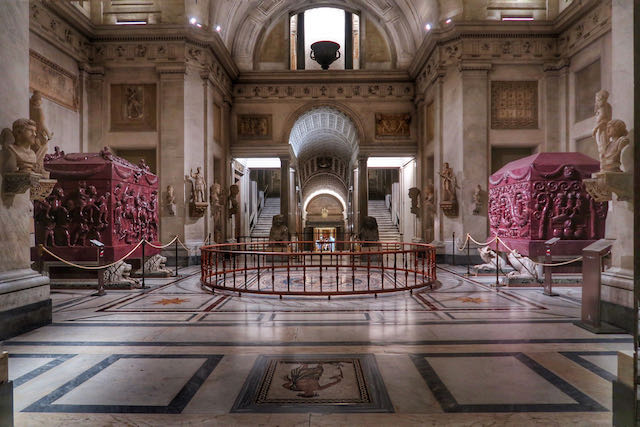 You can see Empress Helena's sarcophagus on the left in this picture of the Vatican Museums - the one on the right was made for Constantine's daughter
You can see Empress Helena's sarcophagus on the left in this picture of the Vatican Museums - the one on the right was made for Constantine's daughterWhen she returned to Rome, she brought with her many of these items, including the whole staircase from Pontius Pilate's palace in Jerusalem.
This staircase was installed in the Lateran Palace.
Helena died a few years after returning to Rome, but after her death she was made a saint.
You can see her stunning and ornate sarcophagus in the Vatican museums today.
⭐️ Marvel at Rome's Stunning Architecture ⭐️
Dive into Rome's majestic basilicas and architectural marvels. Visit San Giovanni, Santa Maria Maggiore, and the Pantheon to uncover the rich history and beauty of these iconic sites.
The Scala Sancta today
After the fall of the (western) Roman empire, the pope became the central power in Rome.
The Lateran Palace was the ancient seat of the papacy, but by the 1500's it was severely outdated and unfit for use.
Pope Sixtus V decided to completely renovate the whole complex, demolishing most of the ancient palace and building a brand new palace adjacent to the grand church of San Giovanni.
He had the staircase rebuilt in its present location across the road from the church and new Lateran Palace, in front of the Sancta Sanctorum, a sanctuary of the holy relics collected over the centuries.
The sanctuary houses the Holy of Holies, so combining the Holy stairs with this sanctuary made sense to the pope.
What are the blood stains on the Holy Stairs?
The blood stains on the Scala Sancta are reputedly Jesus Christ's blood.
Jesus was forcibly led up and down the Holy Stairs on the day of his crucifixion.
The blood is from one point during this torture where, having been violently whipped, Jesus banged his knee as he was dragged up the stairs.
This is where the tradition of ascending the stairs on one's knees originated.
Martin Luther is said to have climbed the stairs on his knees when visiting the holy staircase in 1510 and began the tradition that doing so redeems a soul from purgatory.
The Scala Sancta is now a popular attraction for both Christian pilgrims and other visitors to Rome, and is an important pilgrimage site for Catholics.
There are four blood spot stains on the stairs.
Three of them are covered with crosses.
The constant touching of these spots over the centuries by pilgrims caused the marble to wear away and a deep hole to form, so the fourth is covered by a metal grate.
The perfect 3-day itinerary in Rome
Trying to figure out how to organize your visit to Rome? I've got the perfect 3-day itinerary for first-time visitors (or those who have not been here in a while.) It works for a 2.5 day visit as well.
In my 3-day itinerary, you'll see all the major must-see Rome attractions like the Vatican, Colosseum, Trevi Fountain, Pantheon, Piazza Navona, Spanish Steps, and much more.
And if you have more time, or want suggestions for extra/other things to do, you'll find that there too.
Visit my page with the best 3-day itinerary in Rome for first-timers.
What is the Sancta Sanctorum?
The Sancta Sanctorum, accessed by the Scala Sancta, is a chapel of great importance to the Christian faith.
It was originally the private chapel of the popes and is now a popular place of pilgrimage for Catholics and tourists in Rome.
The chapel was originally a part of the ancient Lateran Palace which served as the offices of the Papacy in the Middle Ages, and is the only part of the original structure that remains.
What is in the Sancta Sanctorum?
Within the Sancta Sanctorum are many important relics, although not as many as there used to be.
A wood reliquary box under the main altar contains the bones of thirteen saints (some say more); these have been there for over a thousand years.
Originally the chapel held much more, but after the ancient palace was demolished, many of the relics were moved to other places.
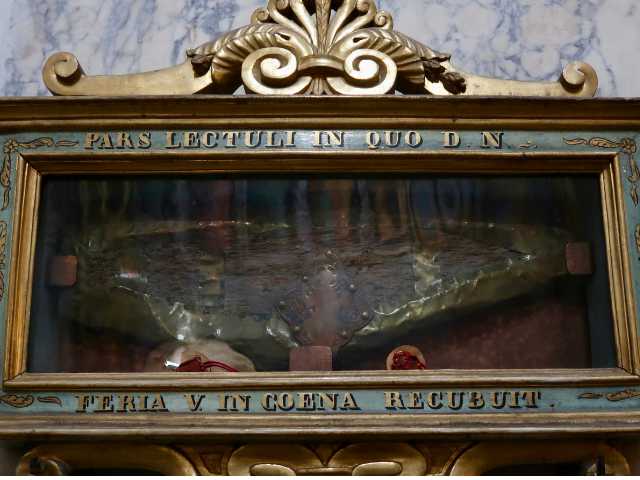 Some relics are still kept in the Sancta Sanctorum, including this fragment of wood said to be part of the bench Christ sat on during the Last Supper
Some relics are still kept in the Sancta Sanctorum, including this fragment of wood said to be part of the bench Christ sat on during the Last SupperThe wonderfully decorative floor in the Cosmatesque style is absolutely beautiful, along with the mosaics above the altar.
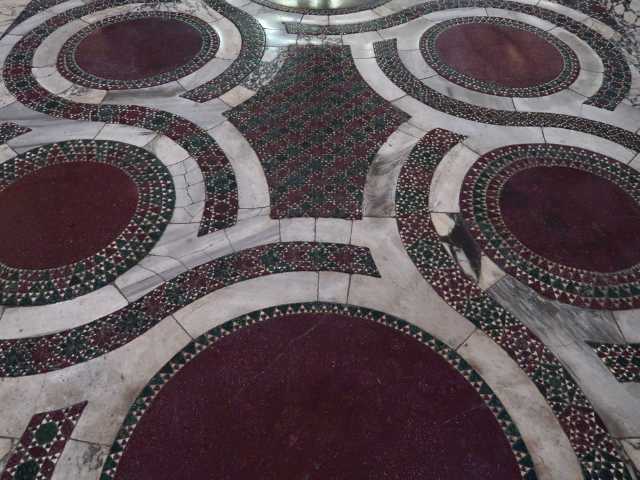 There is an excellent example of the Cosmatesque style flooring in the chapel
There is an excellent example of the Cosmatesque style flooring in the chapelThe most famous item within the sanctuary of the holy chapel is the Acheropita Lateranense.
This icon of Christ is painted on a wooden panel is very old, it is said it was begun by Saint Luke and finished by an angel.
Acheropita means 'an image not made by human hands.'
Over the centuries it has been added to and restored, the version of Christ's face visible today was painted on silk before being applied to the wood panel in the 100's.
Climbing The Holy Stairs In Rome
The Holy stairs must be climbed on your knees, no matter your faith or beliefs.
The steps are covered with wooden planks to protect the marble.
The marble steps of the Scala Santa are famously climbed by pilgrims ascending on their knees, an act that grants them a plenary indulgence.
Over hundreds of years of pilgrim visits, this led to the marble becoming worn and damaged.
In the 1700's they were covered with wood for protection, with small sections left exposed where the blood of Christ can be seen.
In 2019 it was decided to remove the wood for 60 days so that pilgrims and tourists could see the full 28 steps for the first time in 300 years.
The Scala Sancta is now once again protected by wood.
For those unable to climb but who would like to, you can receive your indulgence by saying a prayer at the bottom of the steps.
Can you walk up the Holy Stairs?
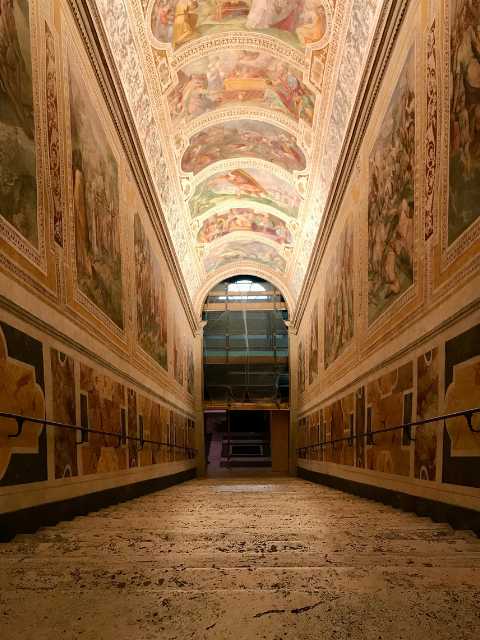 The side stairs are far from plain, but do not hold the same religious significance so you can walk up and down them
The side stairs are far from plain, but do not hold the same religious significance so you can walk up and down themIf you do not wish to climb the Holy Stairs on your knees, there are staircases on either side.
The staircase on the right is for ascending the steps.
The staircase on the left is for descending them.
You can reach the Scala Sanctorum at the top of these stairs.
Ready to plan your trip?
Book your train
Planning to travel between cities in Italy and other parts of Europe?
Use Trainline to see all the different options available across the different rail companies.
Find your hotel
Find your perfect place to stay in Rome.
Use Booking.com to choose between hotels, guesthouses, and self-catering apartments in neighborhoods throughout the Eternal City.
Buy your TurboPass
Purchase the convenient Turbopass and visit all of Rome's top attractions including the Colosseum, Pantheon, and Vatican.
With one handy pass, it's all included.
Where is the other holy staircase in Rome?
The Church of Santa Michele e Magno (St Michael the Archangel), located just outside the border of Vatican City near St Peter's Basilica also has a set of holy stairs.
Lesser known, these stairs are one of two methods of access to this fascinating Roman Catholic church.
These steps may be climbed on the knees as at the Scala Sancta.
In the church's nave, visitors can see the remains of the original Cosmatesque floor, much of which was lost when the church was rebuilt in the 12th century.
The Dutch Catholic community uses the church, with masses held in Dutch every Sunday.
The church is also known as the Church of the Frisians ("Friezenkerk" in Dutch).
Practical matters - location, hours, cost, how to visit, what's nearby
Where are the Holy Stairs located in Rome?
The Scala Sancta is in Piazza di San Giovanni in Laterano, opposite the Basilica of St John in Lateran (San Giovanni in Laterano).
This area is very well connected by public transportation.
You can take Metro line A to the San Giovanni stop which is a few minutes walk away.
There are also multiple bus stops nearby as well as a tram line.
Use Google Maps or Moovit App to see the best public transportation options for your journey.
Is it free to visit the Scala Santa?
It's free to visit the Holy Stairs but to enter the Scala Sanctorum at the top costs 4 euros.
You can book in advance here with an included audio guide, or you can pay on-site.
For more details about what to expect and information for pilgrims, take a look at the official website of the Scala Santa.
What is nearby?
St John in Lateran
The most prominent site to visit nearby the Scala Santa is of course the Basilica of San Giovanni in Laterano.
The huge church is unmissable with a grand facade and is well worth a visit.
Take a look at my page all about it for lots more details!
Lateran Baptistery
The Lateran baptistery, part of the Lateran Palace complex, is a stunning octagonal building where generations of Romans were baptized for centuries.
Repeatedly renovated and added to over the years, the baptistery is well worth a visit for the wealth of art inside.
No matter what season you visit Rome, here are 4 essential things we recommend never leaving home without:
Basilica di Santa Croce in Gerusalemme
The Basilica di Santa Croce in Gerusalemme is also just a short walk away.
This church was constructed partly in the former palace of Saint Helena, the mother of Emperor Constantine.
As this is one of the seven pilgrim churches of Rome, many pilgrims visit this church and its Chapel of Relics where three fragments of the Holy Cross that Helena brought back from her travels are kept.
You'll find your way to Santa Croce in Gerusalemme by going left onto Piazza di San Giovanni in Laterano when you exit, following the ancient Roman Aurelian Wall.
On your way, you'll also pass the Porta San Giovanni, an ornate gate in the old city walls dating back to 1574.
Romewise's Top Travel Resources
Ready to book your trip to Rome? Take a look at these helpful links to companies we use and trust:
- Keep your travel spending simple with the Wise card, which removes all the worry about exchange rates and high transaction fees all over the world
- Search for and book your perfect accommodation
- Our complete guide to what to pack for Rome
- The number one travel accessory, a multi-point travel adapter and voltage converter
- Browse a huge range of tours in Rome and beyond
- Experience unique tours and special access to Rome's most popular sights
- Protect yourself with comprehensive travel insurance
Within this post there are some affiliate links for products and services. For more details about our affiliate policy click here.
Get your 100% free Rome trip planner now!
Simply sign-up today for our free newsletter and get the Romewise Quick Start guide to Rome:
We are committed to respecting your data. Click for our Privacy Policy.
Comments? Questions? Suggestions?
Please come over to the private Romewise Facebook group and join in the conversation.
You will often find me there, happy to answer your questions / comments!
You will also meet other Rome lovers and experts, too.
What are you waiting for?
- Romewise Home Page
- What to Do in Rome
- scala sancta

